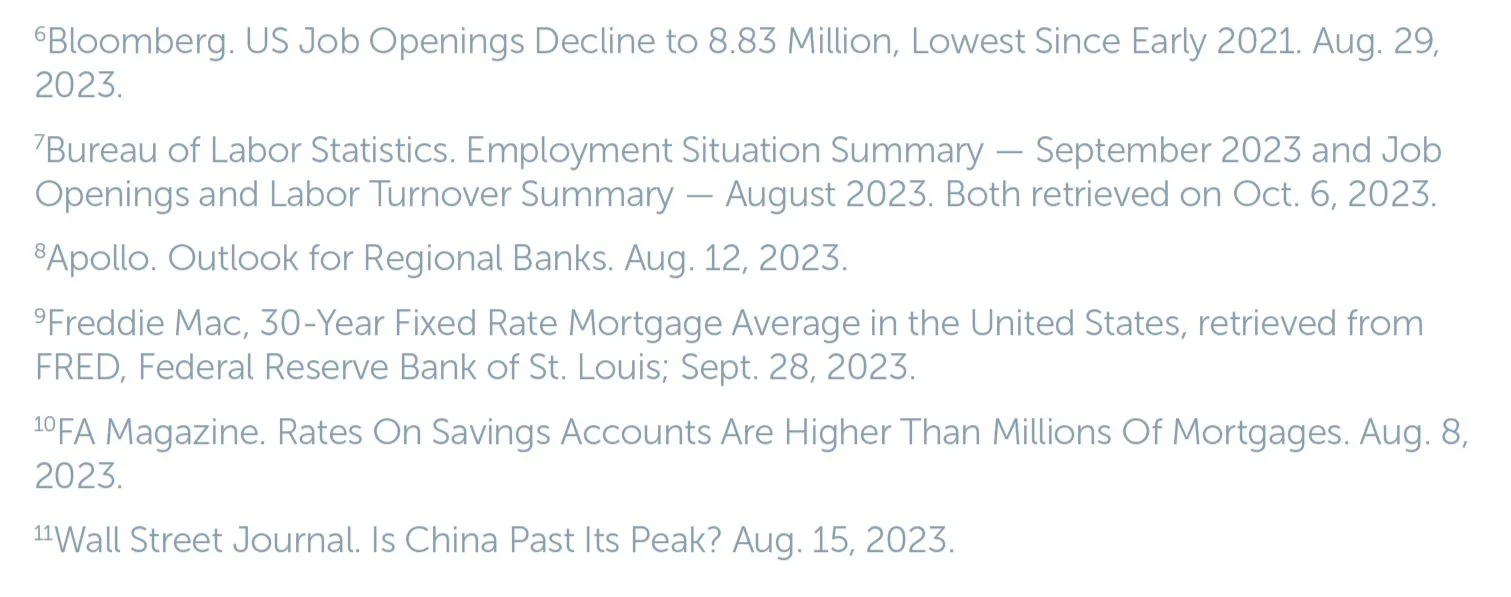Q3 Market Commentary: A Look Back & Ahead
MODERNIST’S ASSET CLASS INVESTING PORTFOLIOS ARE STRATEGICALLY INVESTED WITH A FOCUS ON LONG-TERM PERFORMANCE OBJECTIVES. PORTFOLIO ALLOCATIONS AND INVESTMENTS ARE NOT ADJUSTED IN RESPONSE TO MARKET NEWS OR ECONOMIC EVENTS; HOWEVER, OUR INVESTMENT COMMITTEE EVALUATES AND REPORTS ON MARKET AND ECONOMIC CONDITIONS TO PROVIDE OUR INVESTORS WITH PERSPECTIVE AND TO PUT PORTFOLIO PERFORMANCE IN PROPER CONTEXT.
As evidence-based investors, we use an approach fueled by data with over 50 years of research, rooted in diversification and tax conscious investment options. Time has proven the value of investing. While these quarterly market reviews are helpful for staying informed, we also love to remind our clients and community: focus on what you can control, remember the big picture, and stick to your plan.
market snapshot:
Stock markets continue to watch the Fed and are beginning to accept that it will likely keep rates higher for longer. Although the likelihood of entering a recession in 2023 has declined to basically zero, growth prospects remain constrained by higher costs of labor and capital as well as a higher likelihood that consumer spending will continue to decline.
In the bond market, yields remain elevated, presenting a nice opportunity for high-quality income for investors.
KEY ECONOMIC INDICATORS: AREAS TO WATCH
Economic Growth
While GDP for the third quarter won’t be released until November, the Atlanta Fed’s GDPNow model estimate for real GDP growth is 4.9% as of Sept. 27.(1) This expectation for growth is higher than expected earlier in the year and indicates that the Fed’s policy has not been sufficiently tight to cool the economy, as the federal funds rate has been below the nominal growth of GDP and until recently was not even below the rate of inflation.
Inflation Trajectory
Through August, CPI grew at 3.7% on a year-over-year basis. Core CPI (which excludes the more volatile food and energy sectors) grew at 4.4% on a year-over-year basis. (2) These numbers are lower than earlier in the year, though are still well above the Fed’s long-run 2% target.
Monetary Policy
With economic growth as strong as it is, markets are currently priced for the Fed to maintain the current federal funds rate target (between 5.25% and 5.50%) through January 2024. However, markets are pricing in a 34% chance that the Fed will need to hike rates again before the end of the year. (3)
Fiscal Policy
Economists have been raising concerns that the U.S. government debt burden is reaching unsustainable levels. Fitch, a leading provider of financial data and research, forecasts a fiscal deficit of 6.6% of GDP in 2024 and a further widening to 6.9% of GDP in 2025. (4) Furthermore, disagreement around fiscal priorities is threatening a shutdown in Washington. (5) The debt burden and fiscal strife will likely limit Congress’ ability to respond to future contractions in the economy with fiscal stimulus.
Labor Market
Labor markets remain tight but show some signs of softening. Quit rates, which measure the percentage of employees voluntarily leaving their job, have fallen to the lowest level since 2021 at 2.3%. (6) Unemployment stayed at a historical low of 3.8% in September, but higher rates are starting to have an impact: there were 9.6 million job openings in August, down from the March 2023 peak of 12 million. (7) Furthermore, a prolonged auto strike could create additional challenges for the auto supply chain.
Consumer Spending
Higher interest rates are making credit more expensive, and banks have tightened their lending standards, making credit less available. We’ve seen an increase in delinquencies for credit cards and auto loans, as well as an uptick in businesses filing for bankruptcy protection. (8) Tighter credit conditions, rising delinquencies and student loan payments resuming will likely curtail consumer spending in the quarters ahead.
Housing Market
The market for first-time homebuyers is expected to remain a challenge. The supply of homes is low due to years of sluggish construction, keeping pressure on prices and rents. Meanwhile, current homeowners with an existing mortgage don’t have much incentive to sell. A 30-year fixed-rate mortgage is at 7.2% as of Sept. 21, the highest since May 2001. (9) At the end of June, about 39 million U.S. homes had a mortgage rate below 4.375%, more than 73% of outstanding mortgages in the U.S. (10)
Global Economy
The U.S. economy faces headwinds from slower global economic growth, particularly the Chinese economy, the second largest in the world. Among the reasons is China’s aging population, resulting in fewer workers to support retirees. (11) Trade tensions have led to a slower growth in exports, and fragility in the property sector have added to uncertainty for the Chinese consumer.
Thanks to our reliance on long-term evidence-based investing principals, we know that short term data is too noisy to determine our investing choices. Yet, we always like to offer our review of markets because we believe this information should be accessible to all!





